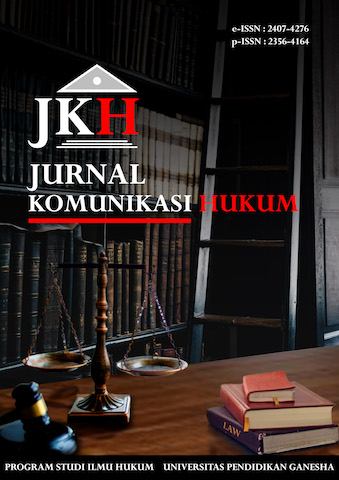KLASIFIKASI PENETAPAN DAERAH TERDEPAN, TERLUAR DAN TERTINGGAL (DAERAH 3T) DALAM REGULASI INDONESIA
Abstract
Management of state boundaries is very necessary and important to provide legal certainty regarding the scope of a country's territory, authority to manage state territory, and sovereign rights. However, it is necessary to observe whether the management of state boundaries so far has provided legal certainty, especially regarding the scope of the Unitary State of the Republic of Indonesia. Considering that so far the management of the country's territorial boundaries has not been maximized which has made two Indonesian islands separated from the territory of the Republic of Indonesia. This article aims to find out how capable a regulation is of providing standard meaning regarding the management of state boundaries, especially regarding what is meant by "frontier", "outermost", and "underdeveloped" areas, and how this regulation is able to classify border areas which in practice termed frontier, outermost and lagging regions. The research method used in this study is a normative approach supported by various library materials, such as reading literature in the form of books, journals, articles in online media, and papers which are then analyzed qualitatively. Basically there are areas that have different characteristics but are placed in the same classification, and there are also areas that have the same characteristics but are placed in different classifications. The Frontier and Outermost Regions have the same position on the state border, while the difference lies in their social conditions. Leading and Disadvantaged Regions have in common the same social conditions, while the difference lies in their position. Between the Outermost and Disadvantaged Regions do not have anything in common.
Downloads
Published
How to Cite
Issue
Section
License
Authors who publish with this journal agree to the following terms:- Authors retain copyright and grant the journal right of first publication with the work simultaneously licensed under a Creative Commons Attribution License that allows others to share the work with an acknowledgement of the work's authorship and initial publication in this journal.
- Authors are able to enter into separate, additional contractual arrangements for the non-exclusive distribution of the journal's published version of the work (e.g., post it to an institutional repository or publish it in a book), with an acknowledgement of its initial publication in this journal.
- Authors are permitted and encouraged to post their work online (e.g., in institutional repositories or on their website) prior to and during the submission process, as it can lead to productive exchanges, as well as earlier and greater citation of published work (See The Effect of Open Access).
Authors who publish with this journal agree to the following terms:
- Authors retain copyright and grant the journal right of first publication, with the work [SPECIFY PERIOD OF TIME] after publication simultaneously licensed under aCreative Commons Attribution License that allows others to share the work with an acknowledgement of the work's authorship and initial publication in this journal.
- Authors are able to enter into separate, additional contractual arrangements for the non-exclusive distribution of the journal's published version of the work (e.g., post it to an institutional repository or publish it in a book), with an acknowledgement of its initial publication in this journal.
- Authors are permitted and encouraged to post their work online (e.g., in institutional repositories or on their website) prior to and during the submission process, as it can lead to productive exchanges, as well as earlier and greater citation of published work (See The Effect of Open Access).












